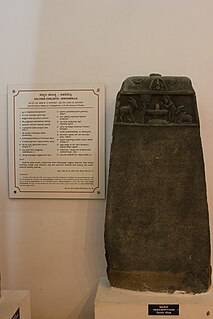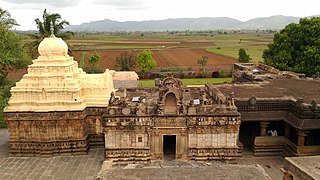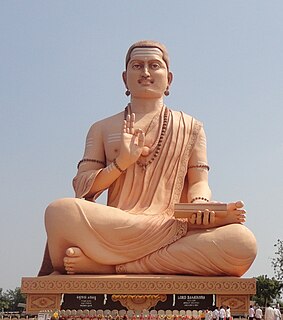
The Middle kingdoms of India were the political entities in India from 200 BCE to 1200 CE. The period begins after the decline of the Maurya Empire and the corresponding rise of the Satavahana dynasty, starting with Simuka, from 230 BCE. The "Middle" period lasted for about 1,500 years and ended in 1200 CE, with the rise of the Delhi Sultanate, founded in 1206, and the end of the Later Cholas.

Raichur District is an administrative district in the Indian state of Karnataka. It is located in the northeast part of the state and is bounded by Yadgir district in the north, Bijapur and Bagalkot district in the northwest, Koppal district in the west, Bellary district in the south, Jogulamba Gadwal district of Telangana and Kurnool district of Andhra Pradesh in the east.

Bagalakote district, is an administrative district in the Indian state of Karnataka. The district headquarters is located in the town of Bagalakote. The district is located in northern Karnataka and borders Belgaum, Gadag, Koppal, Raichur and Bijapur. The new Bagalakote district was carved out of Vijayapura in 1997 via Government of Karnataka directive Notification RD 42 LRD 87 Part III. The bifurcated Bagalakote district consists of nine taluks — Badami, Bagalakote, Bilagi, Guledgudda, Rabkavi Banhatti, Hunagund, Ilkal, Jamakhandi and Mudhol.

The Later Chola dynasty ruled the Chola Empire from 1070 C.E. until the demise of the empire in 1279 C. E. This dynasty was the product of decades of alliances based on marriages between the Cholas and the Eastern Chalukyas based in Vengi, and produced some of the greatest Chola emperors such as Kulothunga Chola I. Even though the later Cholas are often referred to as Chalukya Cholas, there were two breaks in the line. Kulothunga Chola II and Rajadhiraja Chola II did not belong to the Chalukya Chola line. Kulottunga II was a grandson of Vikrama Chola and Rajadhiraja Chola II was not the son of Rajaraja Chola II.

Eastern Chalukyas, also known as the Chalukyas of Vengi, were a dynasty that ruled parts of South India between the 7th and 12th centuries. They started out as governors of the Chalukyas of Badami in the Deccan region. Subsequently, they became a sovereign power, and ruled the Vengi region of present-day Andhra Pradesh until c. 1130 CE. They continued ruling the region as feudatories of the Cholas until 1189 CE.
Mangalesha was a king of the Chalukya dynasty of Vatapi in Karnataka, India. He succeeded his brother Kirttivarman I on the throne, and ruled a kingdom that stretched from southern Gujarat in north to Bellary-Kurnool region in the south, in the western part of the Deccan region. It included parts of present-day Gujarat, Maharashtra, Goa, Karnataka, and Andhra Pradesh.

North Karnataka, is a geographical region in Deccan plateau from 300 to 730 metres elevation that constitutes the region of the Karnataka state in India and the region consists of 13 districts. It is drained by the Krishna River and its tributaries the Bhima, Ghataprabha, Malaprabha, and Tungabhadra. North Karnataka lies within the Deccan thorn scrub forests ecoregion, which extends north into eastern Maharashtra. Most parts of the region has black fertile soil ideal for agriculture.

Tailapa II, also known as Taila II and by his title Ahavamalla, was the founder of the Western Chalukya dynasty in southern India. Tailapa claimed descent from the earlier Chalukyas of Vatapi, and initially ruled as a Rashtrakuta vassal from the Tardavadi-1000 province in the modern Bijapur district of Karnataka. When the Rashtrakuta power declined following an invasion by the Paramara king Siyaka, Tailapa overthrew the Rashtrakuta king Karka II, and established a new dynasty.

Davanagere district is an administrative district of Karnataka state in India. It is the centre of Karnataka. The city of Davanagere is the district headquarters. It had a population of 1,643,494 of which 32.31% was urban as of 2011. This district was separated from Chitradurga district in 1997 by then Chief minister of Karnataka J. H. Patel including Chennagiri and Honali Taluks Shimoga district.

The Western Chalukya Empire ruled most of the western Deccan, South India, between the 10th and 12th centuries. This Kannadiga dynasty is sometimes called the Kalyani Chalukya after its regal capital at Kalyani, today's Basavakalyan in the modern Bidar District of Karnataka state, and alternatively the Later Chalukya from its theoretical relationship to the 6th-century Chalukya dynasty of Badami. The dynasty is called Western Chalukyas to differentiate from the contemporaneous Eastern Chalukyas of Vengi, a separate dynasty. Prior to the rise of these Chalukyas, the Rashtrakuta empire of Manyakheta controlled most of Deccan and Central India for over two centuries. In 973, seeing confusion in the Rashtrakuta empire after a successful invasion of their capital by the ruler of the Paramara dynasty of Malwa, Tailapa II, a feudatory of the Rashtrakuta Dynasty ruling from Bijapur region defeated his overlords and made Manyakheta his capital. The dynasty quickly rose to power and grew into an empire under Someshvara I who moved the capital to Kalyani.

The Kalachuris of Kalyani, also Southern Kalachuris, were a 12th-century Indian dynasty, who ruled over parts of present-day northern Karnataka and Maharashtra. This dynasty rose to power in the Deccan region between 1156 and 1181 CE.

Bijjala II Kannada: ಇಮ್ಮಡಿ ಬಿಜ್ಜಳ was the Mahamandaleshwara of the Kalyani Chalukyas. He was the most famous of the southern Kalachuri kings who ruled initially as a vassal of Chalukya Vikramaditya VI. He ruled as the Mahamandalesvara over Karhada-4000 and Tardavadi-1000 provinces, designations given to territories within the larger Western Chalukya kingdom.

Basavakalyana is a City and municipal council in the Bidar District of the Indian state of Karnataka.

Veera Ballala II was the most notable monarch of the Hoysala Empire. His successes against the Yadavas of Devagiri, the Southern Kalachuris, the Pandyas of Madurai and the waning Western Chalukya Empire, and his domination over the diminishing Cholas of Tanjore took the Hoysalas to their peak of power. The historian Chaurasia claims by the end of the 12th century, Ballala II's conquests had made the Hoysalas the most powerful dynasty of the Deccan. According to historian Derrett, Ballala II was "the most outstanding among Hoysala kings", and historian William Coelho in comparing Ballala II to King Vishnuvardhana writes, "he vied in glory with his grandfather".

Dravidian architecture or the South Indian temple style is an architectural idiom in Hindu temple architecture that emerged in the southern part of the Indian subcontinent or South India and in Sri Lanka, reaching its final form by the sixteenth century. It is seen in Hindu temples, and the most distinctive difference from north Indian styles is the use of a shorter and more pyramidal tower over the garbhagriha or sanctuary called a vimana, where the north has taller towers, usually bending inwards as they rise, called shikharas. However, for modern visitors to larger temples the dominating feature is the high gopura or gatehouse at the edge of the compound; large temples have several, dwarfing the vimana; these are a much more recent development. There are numerous other distinct features such as the dwarapalakas - twin guardians at the main entrance and the inner sanctum of the temple and goshtams - deities carved in niches on the outer side walls of the garbhagriha.

The recorded history of Andhra Pradesh, one of the 28 states of 21st-century India, begins in the Vedic period. It is mentioned in Sanskrit epics such as the Aitareya Brahmana. Its sixth-century BCE incarnation Assaka lay between the Godavari and Krishna Rivers, one of sixteen mahajanapadas. The Satavahanas succeeded them, built Amaravati, and reached a zenith under Gautamiputra Satakarni.

The political history of medieval Karnataka spans the 4th to the 16th centuries, when the empires that evolved in the Karnataka region of India made a lasting impact on the subcontinent. Before this, alien empires held sway over the region, and the nucleus of power was outside modern Karnataka. The medieval era can be broadly divided into several periods: The earliest native kingdoms and imperialism; the successful domination of the Gangetic plains in northern India and rivalry with the empires of Tamilakam over the Vengi region; and the domination of the southern Deccan and consolidation against Muslim invasion. The origins of the rise of the Karnataka region as an independent power date back to the fourth-century birth of the Kadamba Dynasty of Banavasi, the earliest of the native rulers to conduct administration in the native language of Kannada in addition to the official Sanskrit. This is the historical starting point in studying the development of the region as an enduring geopolitical entity and of Kannada as an important regional language.
Aparajita was an able Shilahara ruler of north Konkan branch from 975 CE – 1010 CE.
Basavakalyana fort, earlier known as Kalyana fort, is located in Bidar district in the Indian state of Karnataka. Its historic importance is dated to the 10th century. The capital of Chalukyas was also shifted from Manyakheta to Kalyana in the 10th century. The fort, integral to the Basavakalyana town, is also famous as Karmabhoomi of Basavanna and hundreds of other Sharanas.

The Chalukya dynasty was a Classical Indian dynasty that ruled large parts of southern and central India between the 6th and the 12th centuries. During this period, they ruled as three related yet individual dynasties. The earliest dynasty, known as the "Badami Chalukyas", ruled from Vatapi from the middle of the 6th century. The Badami Chalukyas began to assert their independence at the decline of the Kadamba kingdom of Banavasi and rapidly rose to prominence during the reign of Pulakeshin II. After the death of Pulakeshin II, the Eastern Chalukyas became an independent kingdom in the eastern Deccan. They ruled from Vengi until about the 11th century. In the western Deccan, the rise of the Rashtrakutas in the middle of the 8th century eclipsed the Chalukyas of Badami before being revived by their descendants, the Western Chalukyas, in the late 10th century. These Western Chalukyas ruled from Kalyani until the end of the 12th century.















